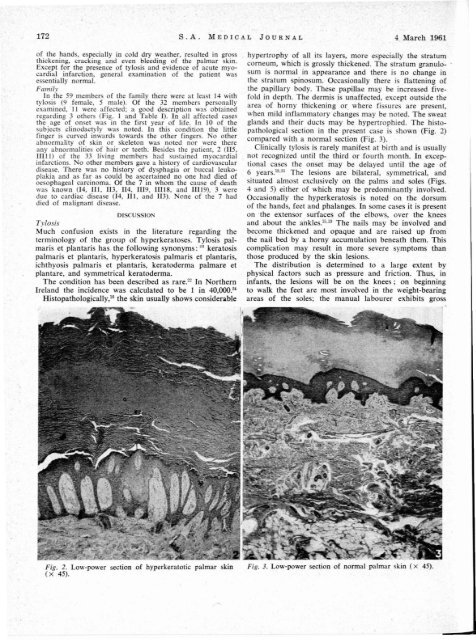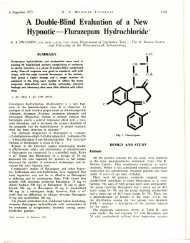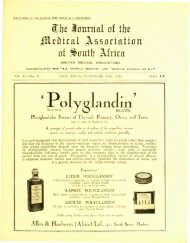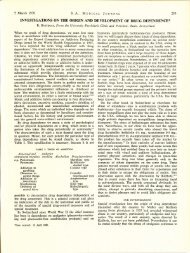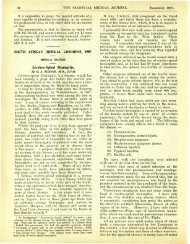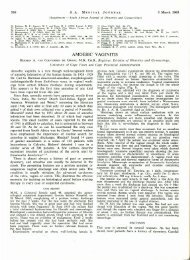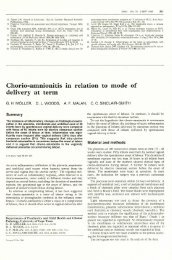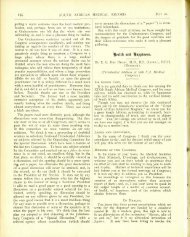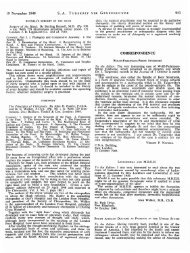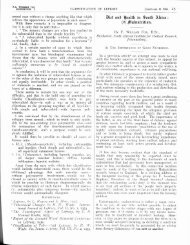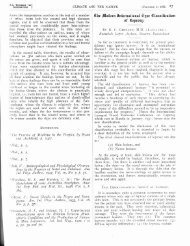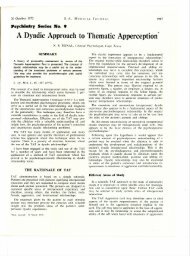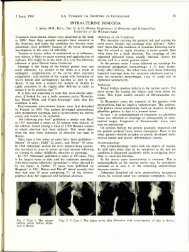tylosis palmaris et plantaris familiaris associated - SAMJ Archive ...
tylosis palmaris et plantaris familiaris associated - SAMJ Archive ...
tylosis palmaris et plantaris familiaris associated - SAMJ Archive ...
Create successful ePaper yourself
Turn your PDF publications into a flip-book with our unique Google optimized e-Paper software.
172 S.A. MEDICAL JOURNAL 4 March 1961<br />
of the hands, especially in cold dry weather, resulted in gm s<br />
thickening, cracking and even bleeding of the palmar skin.<br />
Except for the presence of <strong>tylosis</strong> and evidence of acute myocardial<br />
infarction,<br />
essentially normal.<br />
general examination of the patient was<br />
Family<br />
[n the 59 member of the family there were at least 14 with<br />
<strong>tylosis</strong> (9 female, 5 male). Of the 32 member per onally<br />
examined, 11 were affected; a good de cription was obtained<br />
regarding 3 other (Fig. 1 and Table D. In all affected ca es<br />
the age of on <strong>et</strong> was in the fir t year of life. In 10 of the<br />
ubjects clinodactyly was noted. In this condition the little<br />
finger is curved inwards towards the other fingers. No other<br />
abnormality of skin or skel<strong>et</strong>on was noted nor were there<br />
any abnormalitie of hair or te<strong>et</strong>h. Besides the patient, 2 (1I5,<br />
llIJ I) of the 33 living member bad sustained myocardial<br />
infarctions. 0 other members gave a history of cardiovascular<br />
disease. There wa no history of dysphagia or buccal leukoplakia<br />
and as far as could be ascertained no one had died of<br />
oe ophageal carcinoma. Of the 7 in whom the cause of death<br />
was known (14, Ill, 113, 1I4, ITI9, III18, and IIJI9), 3 were<br />
due to cardiac di ease (14, Ill, and 113). one of the 7 bad<br />
died of malignant disea e.<br />
DISCUSSION<br />
Tylosis<br />
Much confusion exists in the literature regarding the<br />
terminology of the group of hyperkeratoses. Tylosis <strong>palmaris</strong><br />
<strong>et</strong> <strong>plantaris</strong> has the following synonyms: '3 keratosis<br />
<strong>palmaris</strong> <strong>et</strong> <strong>plantaris</strong>, hyperkeratosis <strong>palmaris</strong> <strong>et</strong> <strong>plantaris</strong>,<br />
ichthyosis <strong>palmaris</strong> <strong>et</strong> <strong>plantaris</strong>, keratoderma palmare <strong>et</strong><br />
plantare, and symm<strong>et</strong>rical keratoderma.<br />
The condition has been described as rare.:!:! In Nprthern<br />
Ireland the incidence was calculated to be I in 40,000. 2 '<br />
Histopathologically,IO the skin usually shows considerable<br />
hypertrophy of all its layers, more espe ially the stratum<br />
corneum, which is grossly thickened. The tratum granulosum<br />
is normal in appearance and there is no change in<br />
the stratum spinosum. Occasionally there i flattening of<br />
the papillary body. These papillae may be increa ed fivefold<br />
in depth. The dermis is unaffected, except outside the<br />
area of horny thickening or, where fissures are present,<br />
when mild inflammatory changes may be noted. The sweat<br />
glands and their ducts may be hypertrophied. The histopathological<br />
section in the present case i shown (Fig. 2)<br />
compared with a normal section (Fig. 3).<br />
Clinically <strong>tylosis</strong> is rarely manifest at birth and is usually<br />
not recognized until the third or fourth month. In exceptional<br />
case the ons<strong>et</strong> may be delayed until the age of<br />
6 years. I9 . 23 The lesions are bilateral, symm<strong>et</strong>rical, and<br />
situated almost exclusively on the palms and soles (Figs.<br />
4 and 5) either of which may be predominantly involved.<br />
Occasionally the hyperkeratosis is noted on the dorsum<br />
of the hands, fe<strong>et</strong> and phalanges. In some cases it is present<br />
on ·the extensor surfaces of the elbows, over the knees<br />
and about the ankles. I5 . I9 The nails may be involved and<br />
become thickened and opaque and are raised up from<br />
the nail bed by a horny accumulation beneath them. This<br />
complication may result in more severe symptoms than<br />
those produced by the skin lesions.<br />
The distribution is d<strong>et</strong>ermined to a large extent by<br />
physical factors such as pressure and friction. Thus, in<br />
infants, the lesions will be on the knees; on beginning<br />
to walk the fe<strong>et</strong> are most involved in the weight-bearing<br />
areas of the soles; the manual labourer exhibits gross<br />
Fig. 2. Low-power section of hyperkeratotic palmar skin<br />
(x 45).<br />
Fig. 3. Low-power section of normal palmar skin (x 45).


